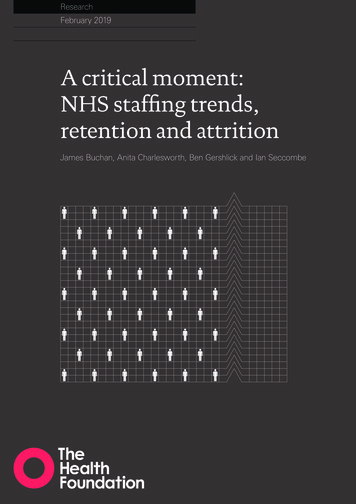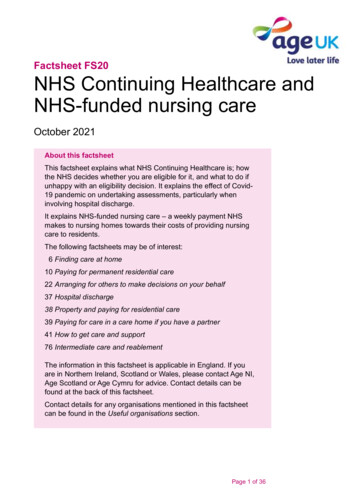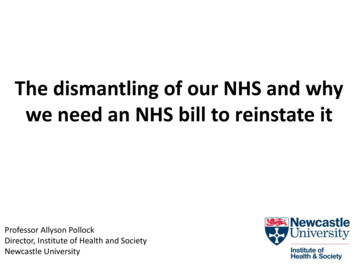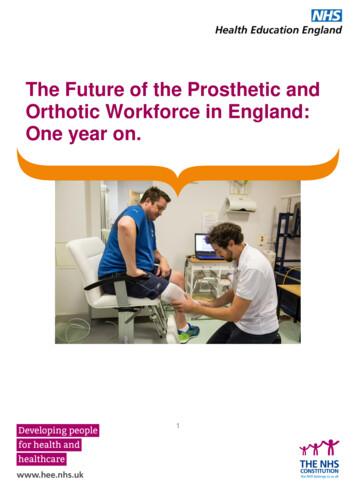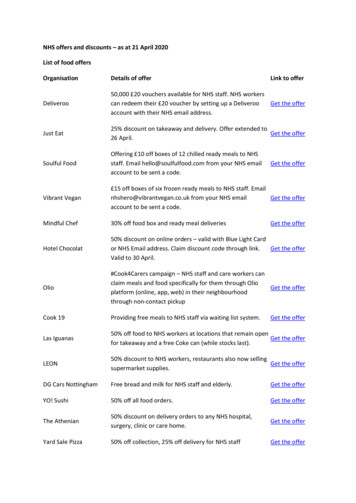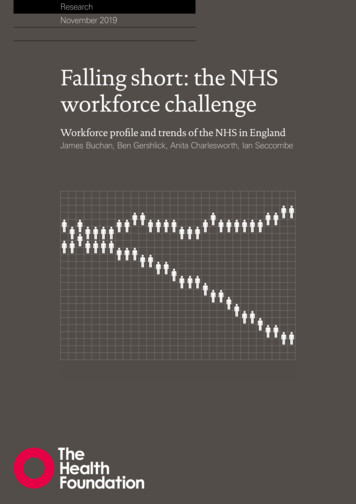
Transcription
ResearchNovember 2019Falling short: the NHSworkforce challengeWorkforce profile and trends of the NHS in EnglandJames Buchan, Ben Gershlick, Anita Charlesworth, Ian Seccombe
AcknowledgementsThe authors would like to gratefully acknowledge the inputof those Health Foundation staff who commented on andcontributed to this text in a variety of ways.They would also like to thank the Nursing Standard forcollaboration on the attrition analysis and those that peerreviewed the publication. Errors or omissions remain theresponsibility of the authors alone.Falling short: the NHS workforce challengeis published by the Health Foundation,8 Salisbury Square, London EC4Y 8APISBN: 978-1-911615-43-9 2019 The Health Foundation
ContentsExecutive summary21 Background82 The NHS workforce in England: profile and trends2.1 The NHS workforce profile2.2 Midwives, nurses and health visitors2.3 Nursing support staff2.4 General practice2.5 Summary1212151820213 Student nurses3.1 The UK picture3.2 How the UK compares internationally3.3 Trends in applications and acceptances by branch of nursing and course3.4 Attrition from pre-registration nurse education23232426334 The international context and international recruitment4.1 International comparisons4.2 Levels of reliance on international health professionals4.3 Summary343437425 Retention436 Key points and conclusion45References48Contents1
Executive summaryThis is the fourth annual NHS workforce trends report published by the HealthFoundation. In it, we analyse the changes in the size and composition of the NHSworkforce in England in the context of long-term trends, policy priorities and futureprojected need. The key findings are as follows.Staff working in NHS hospitals, mental health andcommunity services The number of full-time equivalent (FTE) staff working in the NHS in Englandincreased in 2018/19 by 2.8% (almost 30,000 extra FTE staff). This is the fastestrate of increase in the NHS workforce this decade, but there are marked variationsfor different staff groups. Over the past decade, the proportion of the health service clinical workforce whoare registered nurses has fallen, as numbers of doctors employed in NHS hospitals,mental health and community services have grown at a faster rate than nurses. 2018/19 saw a continuation of this trend: there was a 2.5% increase in the numberof FTE doctors, while the number of FTE nurses grew by just 1.5%. Over the past5 years the number of FTE doctors has increased by 10%, while the number ofFTE nurses has increased by just 3%. At the beginning of the decade there were 3.0nurses per doctor in the NHS, but this figure has now fallen to 2.6. The last decade has also seen a major change in the mix of nurses and clinicalsupport staff (including health care assistants and nursing assistants). In 2009/10there were equal numbers of nurses and support staff, with one clinical support staffmember for every FTE nurse in the NHS. By 2018/19, the number of support staffper FTE nurse had risen 10% to 1.1 FTE per nurse. This skill mix change continued last year. In 2018/19 the NHS employed 6,500more clinical support staff to doctors, nurses, and midwives, which represented a2.6% increase. This compares to 4,500 more FTE nurses, an increase of just 1.5%. Changes in skill mix within the NHS may reflect a range of factors: changing patientneeds, technological developments and legislative changes to allow some staffgroups to expand the scope of their practice. In many cases, skill mix changes areimplemented well, being policy- and evidence-led, with effective programmesto support teams – for example, the introduction of nurse practitioners andpharmacy prescribing.2Falling short: the NHS workforce challenge
It is important that quality and safety are at the forefront of any skill mix change.There is cause for concern about skill mix changes being introduced in an unplannedway in response to negative factors – such as cost pressures or recruitmentdifficulties – rather than positive drivers of improvement. Last year’s staffing increases were unevenly distributed across different parts ofthe NHS. Ambulance staff numbers grew by 5.1% in 2018/19, while the numbersof doctors working in hospital and community health services grew by 2.5%,compared to a less than 1% increase in the numbers working in general practice,including locums and registrars. Within nursing, the number of FTE nurses employed in children’s nursing grewby 2.7%, but mental health nursing numbers grew by just 0.6% and communitynursing service numbers (excluding health visitors) by just 0.7%. The NHS longterm plan ring-fences funding for community and mental health services. But,judging by changes in the nursing workforce, translating this funding commitmentinto increased capacity at the front line has been, and will be, a significant challenge. The combined number of nurses working in community and mental health servicesin 2019 remains below nurse staffing levels in 2014, although higher than the lowsexperienced over the last 4 years, but demand has risen due to population growth,increasing need and the commitment to improve these services. The NHS long term plan and Advancing our health: prevention in the 2020s bothemphasise the importance of health promotion and disease prevention and researchsuggests school nursing services provide cost-effective prevention. Despite this,in 2018/19 the number of school nurses fell by a further 3.1% to just 2,220 FTEsacross England. As in recent years, the largest percentage increase was among managers (6.2%)and senior managers (5.7%). The number of managers and senior managers hasnow increased for 29 consecutive months, although this is in the context of largereductions in numbers in 2013/14. While the NHS is experiencing significant staffing pressures, the issues in social careare even greater and the outlook is concerning. Registered nurse jobs in adult socialcare have decreased by 10,400, or 20%, since 2012, and by 2% between 2017/18and 2018/19.Executive summary3
The changing general practice workforce Alongside investment in community and mental health services, The NHS longterm plan prioritises investment in general practice. In 2016 the General practiceforward view set a target to increase the number of GPs by 5,000 by 2020, comparedwith the number working in the NHS in England in 2014. The target is now thatthis will be reached ‘as soon as possible’. However, the number of people working as fully qualified, permanently employedFTE GPs continues to fall – there was a 1.6% decline from 27,834 in March 2018 to27,381 in March 2019. Temporary staff (locums) and doctors in training (registrarson placement) are making up a greater proportion of the GP workforce, rising from19% in 2018 to 21% in 2019. The growth in temporary and training staff meansthat overall GP numbers increased by 0.9% last year. But it is almost impossible tosee how the original target for 5,000 extra GPs could be met by 2020; if this is to bereached over and above 2015 numbers the number of qualified permanent FTE GPswould need to increase by 6,250 next year. The number of patients that each FTE qualified permanent GP is responsible forcontinues to grow, increasing from 2,120 to 2,180 over the past year. Given theageing population, the rise in chronic disease, and the aim to support more people’shealth needs within the community, general practice services will need to continueto widen the skill mix of their workforce in order to match need and ensure patientscan access care. There are now more non-GP clinical staff working in general practice in Englandthan GPs. Nurses form an important part of the team in most general practices, witharound one nurse for every two GPs. In 2018/19 the number of practice nurses fellby 0.4%, but this was more than offset by an increase in the number of advancedpractice nurses (9.8%). Advanced practice nurses now account for 22% of the nursesworking in GP practices, compared with 17% in 2015. Alongside the expansion in nursing, within general practice other professions areplaying an increasing role in the delivery of care. The past year has seen an almost40% growth in the number of FTE pharmacists working in general practice, from743 to 1,029. This is a trend that will continue with the new contract for general practice, agreedin January 2019, which commits to grow the number of staff from other professions(pharmacists, physiotherapists and paramedics) by 20,000 by 2023/24. Additionalfunding of 900m has been ring-fenced for this purpose. The growth in the UK of registered pharmacists per 1,000 population has been thesecond highest of EU-15 countries. As a result it has gone from being below boththe OECD and EU-15 averages to above both of them.4Falling short: the NHS workforce challenge
Training new nurses The 2018/19 workforce statistics confirm that nursing remains the key area ofshortage and pressure across the NHS. The modest growth in nurse numbers hasnot kept pace with demand, and nursing vacancies increased to almost 44,000 inthe first quarter of 2019/20, which is equivalent to 12% of the nursing workforce.Research by the Health Foundation, The King’s Fund and the Nuffield Trustprojected that, without major policy action, the gap between the number of FTEnurses that are needed to keep up with demand and those available to the NHScould grow to 100,000 in a decade’s time. To prevent nursing shortages growing further, urgent action is needed to increasethe numbers of nurses in training, reduce attrition and improve retention. In 2017, the government set out its intention to grow nursing undergraduateplaces by 25%. This year, the number of applicants to nursing courses in Englandincreased for the first time since the NHS bursary was withdrawn in 2017. This4.6% increase reversed 2 years of decline in which the number of applicants fell byalmost a quarter. The number of applicants in England has now risen to 40,780, butnevertheless it remains below the figure for 2017. Scotland, where the NHS bursary has been retained and its value increased, has seena 6.7% increase this year, taking the number of applicants to its highest ever level. Applications tell part of the story, but as applications have historically significantlyexceeded the number of places available, the key issue for the NHS is not so muchhow many people apply, but rather how many students actually start training(acceptances). In 2018, there were only 80 fewer acceptances in England despite a13.6% fall in applications compared with 2017. The total number of applicants accepted onto nursing courses starting in 2019will not be known until the Universities and Colleges Admissions Service (UCAS)releases the end-of-cycle statistics. In the latest set of figures, released 28 days afterA-level results day, the number of applicants from England who have been placedat universities in the UK is up by 3.9%, at 21,030. This is below the number ofstudents accepted in 2016, but the second highest number of students starting anursing degree this decade. It is still some way short of the additional 4,000 peoplein training by 2023/24 pledged in the NHS long term plan. If the NHS is to reduce vacancies and grow the pool of qualified nurses to recruitfrom, the forthcoming NHS people plan will need to set out measures that willrapidly expand the number of people starting undergraduate nursing degrees inEngland. The 2019 data show that there are different patterns of applications andacceptances by age, branch of nursing and geography.Executive summary5
New data looking at trends in nurse training between 2014 and 2018 show that thenumbers starting mental health and learning disabilities nursing fell significantly in2017, by 10% and 30% respectively. All continuously running learning disabilitycourses have fewer students in 2018 than in 2014. This is in contrast to children’snursing, where around two-thirds (63%) have increased in size. We also see thatfewer over-25s started nursing degrees in 2018 compared with 2016, particularlyimpacting learning disability and mental health courses. Overall trends can also hide pressure points in different areas of the country.Adjusting for population size London and theSouth East are in the bottom threeregions for the number of acceptances to study nursing and the top three for thenumber of vacancies per 100,000 people. A relatively high proportion of students who start a nursing degree do not graduatewithin 3 years – either dropping out completely or putting their studies on hold.The latest data show that attrition remains high despite government commitmentsto reduce it. One in four nurses who were expected to graduate in 2018 did not doso, and this was highest for learning disability courses.International recruitment One consequence of the failure to train, recruit and retain domestic nurses is thatthe UK is, and will continue to be, heavily reliant on international recruitmentto maintain care quality and access. Previous research by the Health Foundation,The King’s Fund and the Nuffield Trust found that the NHS will need to recruit atleast 5,000 nurses a year internationally to avoid a substantial further increase inunfilledposts. The latest data available suggest that in 2017/18 the NHS recruitedjust 1,600 nurses internationally. Since 2016 and the referendum on the UK leaving the European Union (EU), as wellas changes to English language testing requirements, there has been a rapid declinein nurses joining the Nursing and Midwifery Council (NMC) register from the EU,but some increase in non-EU international inflow – mainly from India and thePhilippines. Overall, the number of international nurses joining the NMC registergrew last year, although it is still below the level in 2016/17. How this compares tothe 5,000 nurses a year required will depend on how many of these nurses choose towork and stay in the NHS following registration.6Falling short: the NHS workforce challenge
Conclusions This analysis further highlights the deeply embedded challenge of skills shortagesin key areas of the NHS – nursing, GP services, and community and mental healthservices. The effect of these shortages is increasingly felt through problems withaccess and quality, and this is rippling out to other sectors – notably social care andthe nursing home sector. Our analysis of the nursing workforce this year reinforces several points: the UK hasrelatively few ‘new’ nurses graduating from higher education compared to otherOECD countries; in England NHS nursing numbers have not changed markedlyover the last few years; attrition during undergraduate nurse education continues tobe persistently high; and reliance on international recruitment, which has ebbed andflowed, is on the up again, but with non-EU source countries now being the target. Against this background of supply-side issues, continuing concerns about relativelylow increases in student nurse numbers in England become even more pronounced.Without radical and concerted action in the forthcoming NHS people plan, there is avery real risk that the additional funding committed to the NHS by the current andprevious prime ministers will not deliver tangible improvements in care.Box 1: Recent changes in staff numbersOur analysis focuses on long-term trends in the number of staff working in the NHS and howthese trends have changed over the most recent financial year. Due to the importance of NHSstaff, new data is frequently published detailing the numbers of staff working in the NHS. Thelatest NHS workforce statistics at the time of publication (data 21 November) reinforce thelong-term trends we highlight in this report. Overall growth of the workforce was 3.0%. Nursenumbers grew at just half the rate of support staff (for doctors, nurses, and midwives) at 2.0%vs 4.0%. The lack of growth for nurses working in community services continued, with a fallof 0.2%, while in mental health services there was some growth (1.7%) although levels remainbelow those in 2014. We set out some of these recent changes in Table 1, but our report as awhole focuses on a consistent basis on changes over financial years.Executive summary7
1 BackgroundThis report is the Health Foundation’s annual assessment of trends in the NHS workforce.It examines changes in the overall staff profile of the NHS and identifies key trends. This isthe fourth such report. Our aim over time has been to build progressively on each annualassessment to provide a long-term picture of trends and changing profiles, while alsotaking a year-by-year look at specific ‘pressure points’ that warrant more detailed attention.For this annual cycle, we continue with the primary aim of providing long-term trendsand analysis to place immediate NHS workforce challenges in the appropriate policy andplanning context. This is the last annual report that will be published in this format. It willbe replaced in the future with more rapid periodic evidence updates and analysis on NHSworkforce issues, reflecting both the increased speed with which some workforce dataare available and the rapidly changing NHS funding and policy environments. The HealthFoundation will complement these evidence updates with more in-depth analysis of keyhealth workforce issues that are clear and pressing national priorities.Recent years have seen major staff shortages with national debate focusing on theirnegative impact on NHS services. The Health Foundation has contributed to informingdebate, emphasising the need for more effective targeted funding, more responsive andflexible workforce planning, and investment that is focused on improved staff productivityand retention.Staff shortages continue to dominate the discourse in 2019. Early in the year, the HealthFoundation, in collaboration with The King’s Fund and the Nuffield Trust, publishedClosing the gap – a joint report on the NHS workforce, in the context of the 10-year plan forthe NHS.1 The joint report argued that staffing was ‘the make-or-break issue for the NHS inEngland’. It pointed out that shortages are already having a direct impact on patient care andstaff experience, and that without significant funding and policy action the staff shortfallwas likely to become more pronounced, notably in nursing and primary care.The joint report highlighted nursing and general practice as two critical areas, and madea series of recommendations. These included using the skills of other staff – includingpharmacists and physiotherapists – much more widely in general practice, a ‘radicalexpansion of nurse training’, and an increase in international recruitment. The reportalso noted that the workforce implementation plan due to be published to underpin the10‑year plan would present ‘a pivotal opportunity’. In this review, we return to some ofthe detailed analysis conducted for Closing the gap.At the time of developing this report, we are awaiting the forthcoming NHS people plan.The Interim NHS people plan was published in June 2019.2 It set out the ‘vision for peoplewho work for the NHS to enable them to deliver the NHS long term plan’ but it wasbroad‑brush in nature, and awaiting fuller analysis, stakeholder engagement and costing.We do not focus in any detail on the interim plan in this report.8Falling short: the NHS workforce challenge
Recent independent analysis of the state of the NHS workforce has reinforced the keypoints made by the Health Foundation and its partners. In May, the Migration AdvisoryCommittee (MAC) was charged with assessing which occupations should be on theShortage Occupation List (SOL), and therefore eligible for active international recruitment.It reported a ‘vast increase’ of applications for nurses and doctors.3 These occupations arecurrently provisionally on the list, after lobbying from the professions and employers. TheMAC recommended that nurses should be included on the SOL, noting that a ‘significantnumber of stakeholders reported difficulties in the recruitment of nurses. Vacancy rateshave been rising, even with increased employment, and they ranked relatively highly inthe shortage indicators.’3 More recently, in October 2019, the MAC’s recommendationsthat all medical practitioners, occupational therapists, psychologists, radiographers, speechand language therapists, and social workers be added to the SOL were implemented by thegovernment.4 In this report we will give more attention to active international recruitmentand its vital role in shoring up NHS nurse staffing levels.Another analysis, published by the House of Commons Library in May, noted that therehad been overall growth in the workforce in recent years, but significantly slower growthin nursing staff than in most other NHS occupations; it also highlighted that, since 2015,the number of GPs had fallen.5 A more recent House of Commons Library briefing oninternational workers in the NHS noted that 87% of NHS staff in England are British,and 5.5% are nationals of other European Union (EU) countries – totalling just over65,000 staff. While the overall percentage of EU staff has remained at 5.5% since the EUreferendum, the number of EU nurses has been in decline, and the number of EU nationalsjoining the NHS workforce has also been falling.6The deep-rooted problem of staff shortages was also reinforced by the NHS Pay ReviewBody. In its July 2019 report, it noted that:‘The workforce gap we recognised in our last report persists and continues to createunsustainably high levels of vacancies, work pressures and potential risks to patientcare The trends in the nursing workforce are a particular concern with increasingnursing vacancy rates and substantial declines in the number of people applying fornursing degrees in the last 2 years in particular from mature students who represent60% of entrants.’7Over the past year, an additional workforce challenge has emerged, as the impact of thepension cap has led to some senior doctors retiring early, or reducing their working hours.This is reportedly having an effect on waiting lists. The government has recently signed offa short-term scheme to try and alleviate the problem for clinicians. Similarly, a proposed‘fix’ to the scheme has been out for consultation. NHS Employers has responded that theproposal ‘should apply to all NHS employees, to ensure the NHS Pension Scheme cancontinue to be used as a central part of the overall reward offer to attract, recruit and retainstaff’ and that, as proposed, it will ‘only partly meet the forthcoming objectives set out inthe NHS England/Improvement People Plan’.1 Background9
Workforce challenges are also highlighted in social care. Both the NHS and social careemployers recruit from the same pool for many care-giving roles. Recent analysis8 showsthat the estimated number of adult social care jobs in England in 2018 was 1,620,000, ofwhich 1,225,000 (76%) were direct care staff jobs and another 84,000 (5%) were regulatedprofessionals, including 41,000 registered nurses (these are nurses not working in NHS).While overall numbers were up by 1.2% on the previous year, registered nurse jobs in adultsocial care have decreased by 10,500, or 20%, since 2012. Projections based on the analysisfound that if the adult social care workforce grows proportionally to the projected numberof people aged 65 and over in the population, then the number of adult social care jobs willincrease by 36% (580,000 jobs) to around 2.2 million jobs by 2035.Much of the emphasis on workforce analysis focuses on the supply side – on trends andnumbers, on vacancies and workforce flows. It is also important to keep in mind that theworkforce is the means of achieving safe, effective and timely care. This is particularlyimportant when the continued, more rapid growth in activity in comparison to workforceis noted. For example, as shown in Figure 1, while ‘output’ (including the number ofoperations, consultations, diagnostic procedures and A&E visits in a year) grew by almosta quarter between 2010/11 and 2016/17, the number of nurses grew by less than a tenthof that.Figure 1: Service output and FTE nursing staff numbers in the NHS Hospital andCommunity Health Service, 2010/11–2016/17% change25% 23%Output20%15%10%5%Number of FTE nurses �20142014–20152015–20162016–2017Source: NHS Digital, NHS Workforce Statistics; ONS, Public service productivity: healthcare, England. Note: output iscost and quality adjusted activity10Falling short: the NHS workforce challenge
The impact of staff shortages on existing staff in terms of increased workload, job-relatedstress and ‘burnout’ is also a cause for concern. For example, the most recent NHS StaffSurvey highlighted that only a third of NHS workers felt there were enough staff for themto do their jobs properly, and that reported stress levels are at a 5-year high, with 40% ofrespondents reporting work-related stress within the last 12 months.9Detailed analysis of Staff Survey results by the Picker Institute and The King’s Fund,published in 2018, highlighted that NHS staff workplace experience was associated withsickness absence rates and spend on agency staff and staffing levels, indicating that theworkforce was ‘overstretched and supplemented by temporary staff’ which was negativelyaffecting staff wellbeing. It also noted that there were negative associations between patientexperience and workforce factors, including ‘higher spend on agency staff, fewer doctorsand especially fewer nurses per bed, and bed occupancy’. The report concluded that carequality was at risk from staffing issues, observing that: ‘Staff-reported experience wascorrelated with patient feedback in several areas, notably between staff perceptions of carequality and patient experience, indicating that staff and patients’ perceptions about qualityof care are consistent.’10Further concerns about the impact of workload on staff were highlighted in the reportby the Care Quality Commission (CQC), State of care, published in mid-October 2019.The CQC reported that ‘Growing pressures on access and staffing risk creating a “perfectstorm” for people using mental health and learning disability services’,11 with a nationalshortage of nurses in these areas. It also noted that, more broadly across health and socialcare, ‘access and staffing are presenting challenges across all care settings, with geographicdisparities’ and also regional variation in the ability of services to recruit and retain staff.The CQC report points to workforce solutions related to the development of new roles andan emphasis on upskilling existing staff, including advanced nurse practitioners, nursingassociates, physician associates, pharmacists, district nurses, mental health practitionersand social prescribing workers, working within GP practices.12This report builds on those of previous years to provide analysis of longer-term trends andinsights into the changing NHS staff profile. It also focuses specifically on the critical NHSworkforce issues that have been repeatedly identified in recent years: nursing shortages,and shortages of staff in general practice and primary care. We first present an overviewof the NHS workforce in England, before examining trends in the supply of studentnurses. Next, we examine the international flow of health professionals and place the UKin an international context. Finally, we focus on staff retention, before summarising thekey workforce challenges that will need to be considered in the development of the fullNHS people plan.1 Background11
2 The NHS workforce in England:profile and trendsOur previous report, A critical moment, described modest and patchy growth in theNHS workforce, with almost no increase in the overall number of registered nurses andfurther reductions in the community health services workforce. We acknowledged thechanging skill mix and the growing numbers of support staff in employment. In generalpractice we highlighted the falling number of qualified permanent GPs and the increase inother direct patient care staff. This section summarises recent trends in the NHS and GPpractice workforces, looking at the 12 months of the financial year 2018/19 to the end ofMarch 2019.2.1 The NHS workforce profileThe NHS workforce statistics for March 2019,13 covering NHS Hospital and CommunityHealth Service (HCHS) staff groups in England, show a total workforce of 1.24 million(headcount) and an overall increase of 2.8% (29,355) in the full-time equivalent (FTE)workforce since March 2018. At the same time, the number of posts advertised as vacant inthe 3 months to 31 March 2019 was 2.4% higher, at 89,589 FTE, than in the same periodin 2018.This is by far the largest increase in the NHS workforce this decade. However,professionally qualified clinical staff (2.2%) and clinical support staff (2.8%) have grownmore slowly than NHS infrastructure support staff (4.7%) – see Table 1.12Falling short: the NHS workforce challenge
Table 1: Change in staff groups in the NHS in England (%), Hospital andCommunity Health Service, March 2018–March 2019 (FTE)Staff group20182019Change% change2018/19August 18 toAugust 19Professionally qualifiedclinical 312,6852.52.2Nurses and health 870800.40.6Ambulance staff20,55221,6101,0565.1*Scientific, therapeutic andtechnical staff136,549141,2504,7013.43.4Support to clinical staff318,133327,0188,8862.8*Support to doctors, nursesand midwives245,602252,0606,4582.64.0Support to ambulance staff15,21915,9797605.0*Support to scientific, therapeuticand technical staff57,31258,9801,6672.93.0NHS infrastructuresupport staff167,617175,4767,8594.74.7Central functions82,64986,1573,5074.25.5Hotel, property and estates52,38054,7632,3844.63.4Senior l1,064,2831,093,63829,3552.83.0
4 Falling short: the NHS workforce challenge The changing general practice workforce Alongside investment in community and mental health services, The NHS long term plan prioritises investment in general practice. In 2016 the General practice forward view set a target to increase the number of GPs by 5,000 by 2020, compared with the number working in the NHS in England in 2014.


